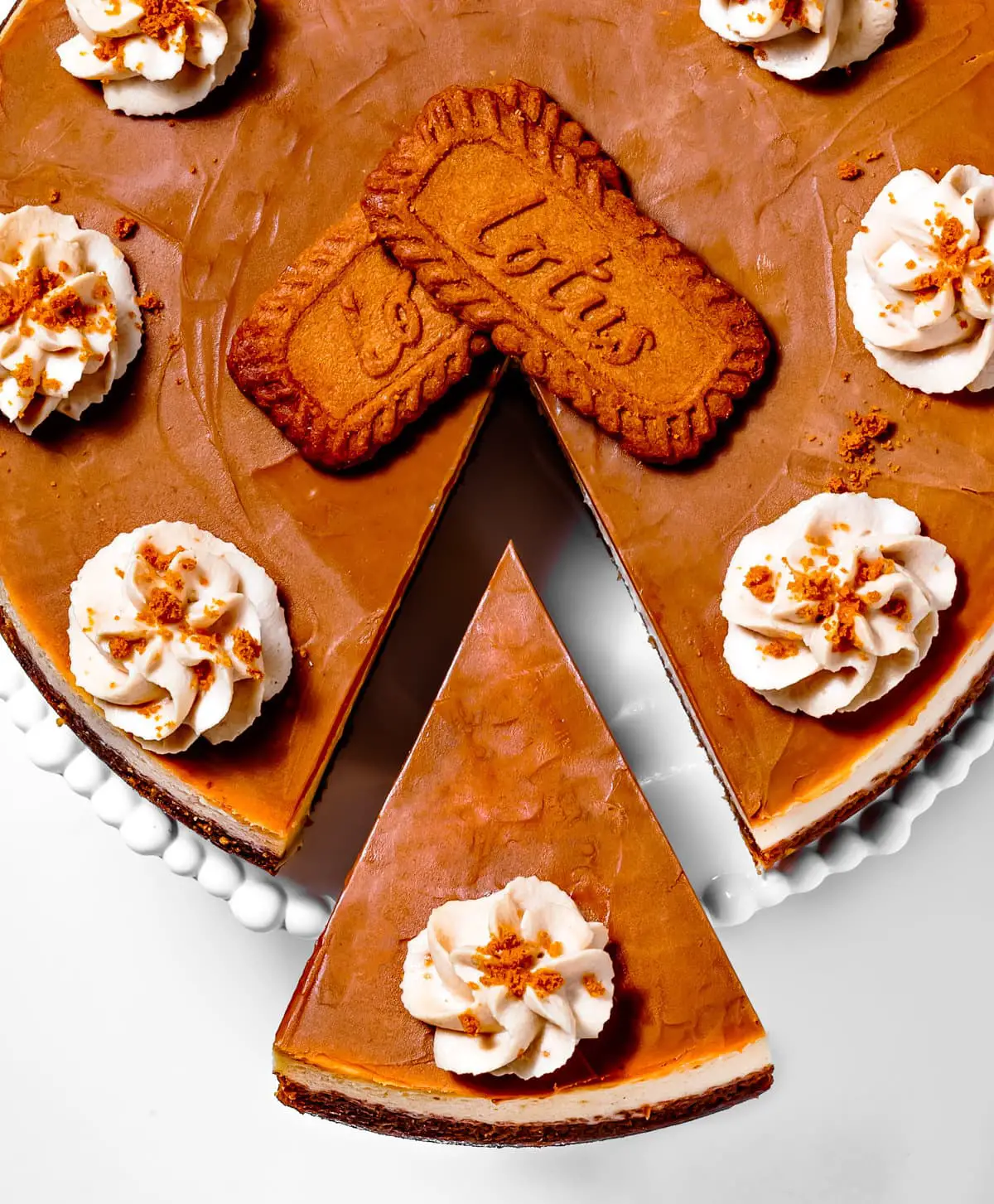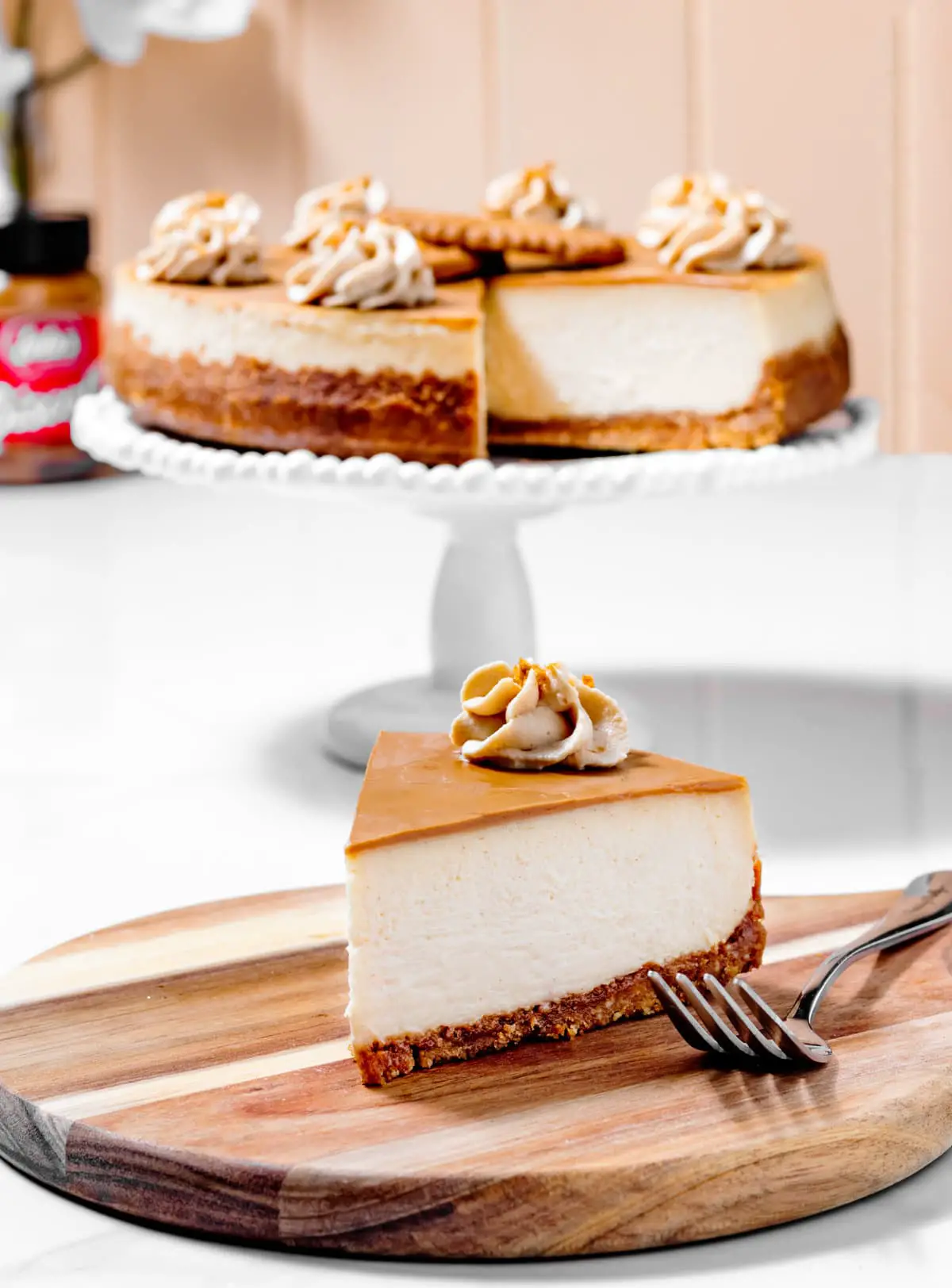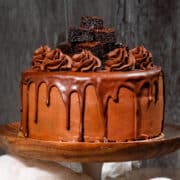This biscoff cheesecake features a crunchy biscoff cookie crust, a thick, creamy cookie butter cheesecake filling, and an easy cookie butter glaze topping.

As if cookie butter wasn't dangerous enough already, just wait until you try this biscoff cookie butter cheesecake! Everything about it tastes incredible, from the crunchy, gooey cookie crust, the perfectly sweet, tangy cheesecake filling, and the addicting cookie butter glaze on top!
WHAT IS COOKIE BUTTER
Cookie butter is a spread that has a texture similar to peanut butter, but instead of peanuts it's made from ground cookies! Technically it can be made with any ground cookie, but the kind sold in stores is made with biscoff (or speculoos) cookies, which are brown sugar and cinnamon spiced Belgium cookies.
INGREDIENTS FOR BISCOFF CHEESECAKE
BISCOFF COOKIE CRUST
- Biscoff (or speculoos) cookies: Crushed into crumbs. For 1 and ¾ cups you will need about 28 cookies.
- Brown sugar: Brown sugar helps bind the crust and the addition of molasses makes it extra chewy and gooey!
- Melted butter: Salted or unsalted is fine!
BISCOFF CHEESECAKE FILLING
- Cream cheese: Brick-style, full-fat, and softened to room temperature. It's important the cream cheese is completely soft or you'll have lumps in the filling. To speed up softening place the foil-wrapped cream cheese package in a plastic bag and submerge the bag in room temperature water for a few minutes.
- Cornstarch: Makes the filling stronger and helps prevent cracks!
- Granulated sugar: A little less sugar makes up for the addition of cookie butter in the filling.
- Sour cream: Full-fat and room temperature!
- Lemon juice: The acidity of fresh-squeezed lemon juice helps thicken the filling.
- Cookie butter: You can find cookie butter at most grocery stores next to the other nut butters. I prefer creamy cookie butter so the filling and glaze are smooth, but if all you have is crunchy that will also work!
- Eggs: Always use room temperature eggs for cheesecake! Room temperature eggs mix more easily into the batter without overmixing. Leave the eggs out on your counter for at least an hour, or place them in a bowl of lukewarm (not hot!) water for a few minutes to bring them to room temperature.
COOKIE BUTTER GLAZE
- Cookie butter: Creamy biscoff or speculoos cookie butter, melted to a pourable consistency.

WATER BATH FOR CHEESECAKE
A water bath (bain-marie) is a French method of baking something surrounded by boiling water. It allows for slow, gentle, even cooking, which is perfect for delicate desserts like cheesecake. Basically, no matter how hot your oven is, the temperature of the water won't get any higher than 212°F (100°C). Without a water bath, the outside of the cheesecake would be over baked and cracked before the center could finish baking.
- To keep water from seeping into the pan from the water bath, make sure you wrap it well with several layers of heavy-duty aluminum foil. *Note: No matter how well you wrap your springform pan with foil, there's still a chance of water leaking in and ruining your otherwise perfectly good cheesecake. This happened to me several times, so now I always tie a slow cooker liner around the pan after wrapping it with foil. My cheesecakes have come out perfectly dry ever since!
HOW TO MAKE BISCOFF CHEESECAKE
Arrange your oven rack to the lower position. Preheat your oven to 325°F. Begin boiling water for the water bath.
Line the bottom of a 9 or 10" springform pan with parchment paper. Lightly spray the sides of the pan with nonstick spray.
MAKE THE COOKIE BUTTER CRUST
Add the biscoff cookies to a food processor and pulse into fine crumbs. Mix 1 and ¾ cups of cookie crumbs with brown sugar and melted butter in the food processor and pulse until the mixture comes together.
Press the crust tightly and evenly into the bottom and slightly up the sides of the springform pan.

Wrap the pan tightly with at least 4 layers of heavy-duty aluminum foil to keep water leaking in from the water bath.
Tie a slow cooker oven liner around the pan.

If you don't have a liner, make sure the pan is wrapped very well with several layers of heavy-duty foil. Without a liner you can expect water to leak through the first few layers of foil.
Place the pan on a baking sheet and prebake the crust for 10 minutes while you make the cheesecake filling.
MAKE THE CHEESECAKE FILLING
- Use a hand-held mixer or a stand mixer with a paddle attachment to beat the softened cream cheese until smooth. Wipe any lumps of cream cheese off of the mixers.
- Mix in the cornstarch, granulated sugar, and cookie butter until smooth. Wipe any lumps off of the mixer and sides of the bowl. Add the room temperature sour cream, fresh-squeezed lemon juice, salt, and ground cinnamon. Mix until combined and the batter is smooth.
- Switch to a whisk and mix in the room temperature eggs, one at a time, until just combined after each. Don't overmix.
- Pour the cheesecake batter into the springform pan over the prebaked crust. Bang the pan on your counter a few times to get rid of any trapped air bubbles in the filling.

BAKE THE CHEESECAKE
- Place a large roasting pan on the lower rack in your oven and add about an inch of boiling water. Carefully set the cheesecake inside the roasting pan. Bake the cheesecake for 1 hour without opening the oven door.
- After 1 hour, check if the cheesecake is done by gently shaking the pan. If the cheesecake is set around the edges and there is a 2 inch wobbly center, then it's done. If it's still wobbly around the edges, keep baking and check again in 5-minute intervals until it's done baking. Mine needed 1 hour and 15 minutes total. If you're uncertain whether it looks done, know that it's better to under-bake a cheesecake than it is to over-bake one!
- Once the cheesecake is done, turn your oven off and crack the door. Leave the cheesecake in the oven for 1 hour to slowly cool to room temperature. Then, remove the cheesecake from the oven and let it cool for at least another hour at room temperature before refrigerating. Once the cheesecake is completely cooled to room temperature, refrigerate it (still in the springform pan) overnight so it can set.
COOKIE BUTTER GLAZE
Melt the cookie butter by microwaving for about 30 seconds, drizzle the melted cookie butter on top of the cheesecake.

Use an offset spatula to spread the cookie butter glaze evenly over the top of the cheesecake.

Top with whipped cream and sprinkle come cookie crumbs on top, if desired.
To get clean slices: Use a large, sharp knife to slice the cheesecake. Run the knife under hot water and wipe it clean between each slice.

HOW TO PREVENT CRACKS IN CHEESECAKE
Don't overmix: Overmixing creates pockets of air in the batter that can rise up during baking and turn into cracks. This is especially true once the eggs are added. So add them last and mix the batter as little as possible once they're added.
Don't open the oven door: At least not for the first hour, which is when the cheesecake is the most delicate. Opening the door causes a sudden change in temperature which can lead to cracks.
Don't over-bake: The cheesecake is done when there is a slight wobbly center and the edges are set. It will continue to bake and become set as it cools. If you're unsure, it's usually better to under bake a cheesecake than it is to overbake one.
Cool the cheesecake slowly: Sudden changes in temperature is one of the main reasons cheesecakes crack. Cooling the cheesecake as slowly as possible is the best way to avoid any drastic changes in temperature. When you turn the oven off, leave the cheesecake in with the door open for about an hour. Then take the cheesecake out of the oven and let it cool completely at room temperature for another 1-2 hours before refrigerating. It shouldn't feel warm at all when you put it in the fridge.
HOW TO STORE BISCOFF CHEESECAKE
Wrap the cheesecake with plastic wrap or store in an airtight container and keep in the fridge for up to 5 days.
You can also freeze the cheesecake for 3 months. Wrap it well with plastic wrap and place in a container that will protect it from getting damaged. When ready to serve, thaw the frozen cheesecake in the fridge for a few hours, or thaw at room temperature for about 30 minutes.

MORE CHEESECAKE RECIPES
- Marble Cheesecake
- Mini Strawberry Cheesecakes
- Chocolate Chip Cheesecake
- Strawberry Crunch Cheesecake
- White Chocolate Cheesecake
📖 RECIPE

Biscoff Cheesecake
Equipment
- 9 or 10" springform pan
Ingredients
Biscoff Cookie Crust:
- 1 and ¾ cups biscoff cookie crumbs, about 28 cookies
- ¼ cup brown sugar
- 6 tablespoons butter , salted or unsalted, melted
Cheesecake Filling:
- 24 ounces cream cheese, full-fat, softened to room temperature
- 1 cup granulated sugar
- 1 tablespoon cornstarch
- ½ cup creamy biscoff cookie butter
- ¼ cup sour cream, full-fat, room temperature
- 1 teaspoon fresh-squeezed lemon juice
- ½ teaspoon ground cinnamon
- ¼ teaspoon salt
- 3 large eggs, room temperature
Cookie Butter Glaze:
- ¼ cup creamy biscoff cookie butter, melted
Instructions
- Line the bottom of a 9 or 10" springform pan with parchment paper. Lightly spray the sides of the pan with nonstick spray.
- Wrap the pan with several layers of heavy duty aluminum foil, then tie a slow-cooker oven liner around it (recommended) to keep water leaking into the pan from the water bath.
- Arrange your oven rack to the lower position. Preheat your oven to 325°F and start boiling water for the water bath.
Make the Biscoff Cookie Crust:
- Add the biscoff cookies to a food processor and pulse into fine crumbs. Add the brown sugar and melted butter and pulse until the mixture is well combined and clumps together easily. It should have a texture similar to wet sand.
- Spread the crust mixture out in the prepared pan. Use the bottom of a glass or measuring cup to pack it tightly and evenly into the bottom and slightly up the sides of the pan. Bake the crust for 10 minutes while you make the filling.
Cheesecake Filling:
- In a large bowl, use an electric mixer to beat the softened cream cheese until smooth with no lumps. Wipe any lumps off of the mixer and sides of the bowl. Add the granulated sugar and cornstarch and mix until well combined.
- Mix in the cookie butter, room temperature sour cream, fresh-squeezed lemon juice, ground cinnamon, and salt. Wipe the sides of the bowl with a rubber spatula. Make sure the filling is completely smooth and there aren't any lumps at this point.
- Switch to a whisk and mix in the room temperature eggs, one at a time, until just combined after each. Mix just until the batter is smooth once you've added all of the eggs. Tap the bowl of cheesecake batter on your counter several times to release any trapped air bubbles.
- Pour the cheesecake batter into the pan over the prebaked crust. Tap the pan on your counter gently to spread the batter out and get rid of trapped air bubbles.
Bake:
- Place a large roasting pan on the rack in your oven. Add about an inch of boiling water to the pan, then gently place the cheesecake inside the pan.
- Bake the cheesecake for 1 hour. Gently shake the pan to check on it, if it looks set around the edges and there's a 2-3" wobbly center, then it's done. If it looks really wobbly all over, keep baking and check again in 5-minute intervals. Mine needed 1 hour + 15 minutes total, but the time can vary. When in doubt, it's better to slightly under-bake the cheesecake than it is to over-bake it.
- When the cheesecake looks done, turn the oven off and leave the cheesecake inside with the door open for 1 hour to slowly cool to room temperature. It will continue to bake and set as it cools in the oven.
- Remove the cheesecake from the oven and the water bath and let cool completely at room temperature. About 1-3 hours, it shouldn't feel warm at all when you put it in the fridge. Refrigerate overnight, uncovered and still in the springform pan.
Cookie Butter Glaze:
- Melt the cookie butter by microwaving for about 30-seconds, or until it's a pourable consistency. Pour the cookie butter over the cooled cheesecake and use an offset spatula to spread it out evenly.
- Top with whipped cream and crushed biscoff cookies when ready to serve.


















Leave a Reply